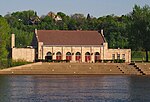Minnesota Centennial Showboat

Minnesota Centennial Showboat was a traditional riverboat theatre docked at Harriet Island Regional Park on the banks of the Mississippi River in downtown Saint Paul, Minnesota, United States. The showboat contained an intimate jewelbox theatre that seated 225. The interior was decorated to keep in time with the Victorian Era style commonly associated with showboats. The Minnesota Centennial Showboat was run through a partnership with the University of Minnesota Theatre Department and the Padelford Boat Company. The showboat was a longtime tradition with the University beginning in 1958. The University Theatre utilized the showboat as a learning opportunity for its students to experience professional theatre. The showboat had its final performance in 2016.
Excerpt from the Wikipedia article Minnesota Centennial Showboat (License: CC BY-SA 3.0, Authors, Images).Minnesota Centennial Showboat
Harriet Island Road, Saint Paul West Side
Geographical coordinates (GPS) Address Phone number Website External links Nearby Places Show on map
Geographical coordinates (GPS)
| Latitude | Longitude |
|---|---|
| N 44.939722222222 ° | E -93.095833333333 ° |
Address
Minnesota Centennial Showboat
Harriet Island Road
55146 Saint Paul, West Side
Minnesota, United States
Open on Google Maps











